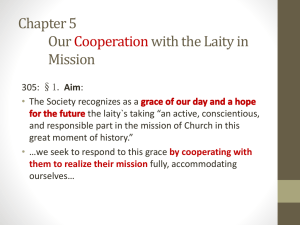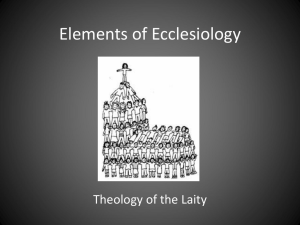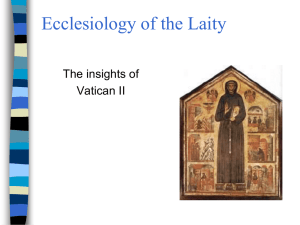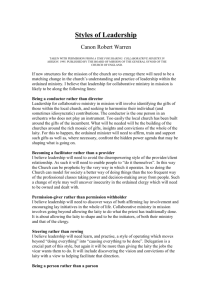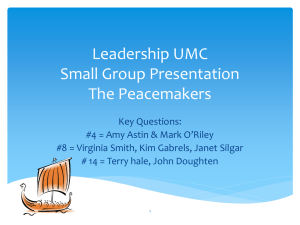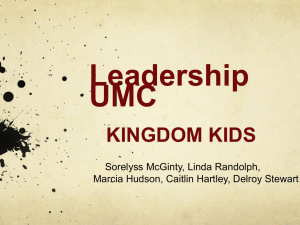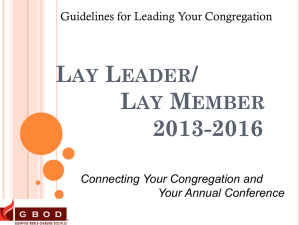Persistent Presbyterians
advertisement
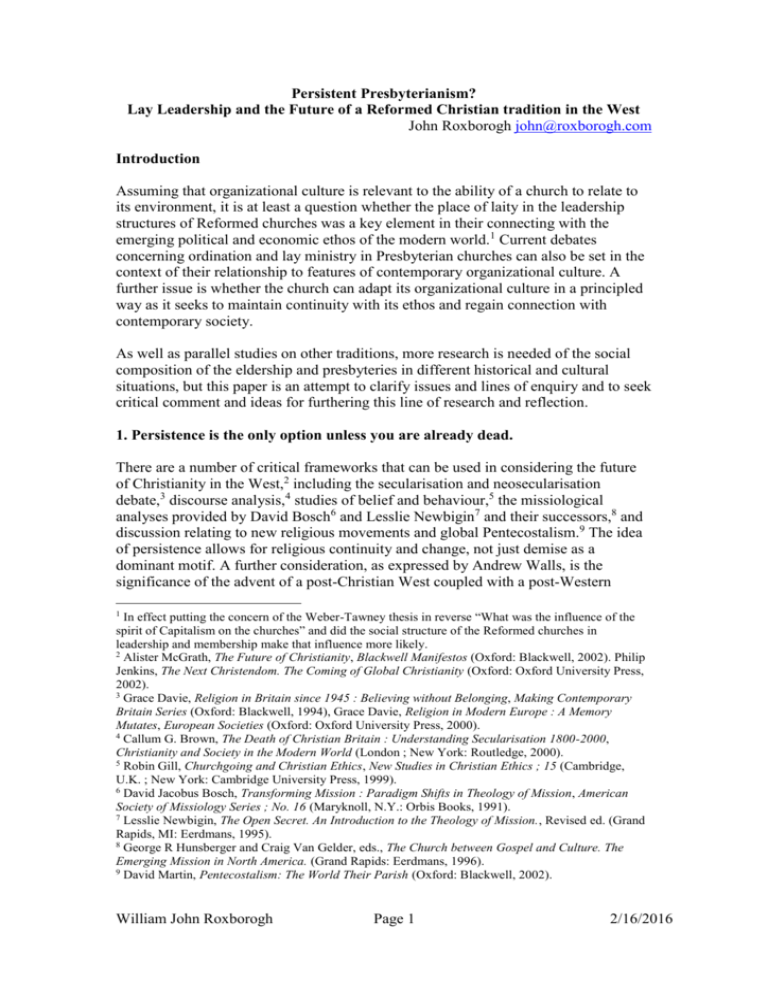
Persistent Presbyterianism? Lay Leadership and the Future of a Reformed Christian tradition in the West John Roxborogh john@roxborogh.com Introduction Assuming that organizational culture is relevant to the ability of a church to relate to its environment, it is at least a question whether the place of laity in the leadership structures of Reformed churches was a key element in their connecting with the emerging political and economic ethos of the modern world.1 Current debates concerning ordination and lay ministry in Presbyterian churches can also be set in the context of their relationship to features of contemporary organizational culture. A further issue is whether the church can adapt its organizational culture in a principled way as it seeks to maintain continuity with its ethos and regain connection with contemporary society. As well as parallel studies on other traditions, more research is needed of the social composition of the eldership and presbyteries in different historical and cultural situations, but this paper is an attempt to clarify issues and lines of enquiry and to seek critical comment and ideas for furthering this line of research and reflection. 1. Persistence is the only option unless you are already dead. There are a number of critical frameworks that can be used in considering the future of Christianity in the West,2 including the secularisation and neosecularisation debate,3 discourse analysis,4 studies of belief and behaviour,5 the missiological analyses provided by David Bosch6 and Lesslie Newbigin7 and their successors,8 and discussion relating to new religious movements and global Pentecostalism.9 The idea of persistence allows for religious continuity and change, not just demise as a dominant motif. A further consideration, as expressed by Andrew Walls, is the significance of the advent of a post-Christian West coupled with a post-Western In effect putting the concern of the Weber-Tawney thesis in reverse “What was the influence of the spirit of Capitalism on the churches” and did the social structure of the Reformed churches in leadership and membership make that influence more likely. 2 Alister McGrath, The Future of Christianity, Blackwell Manifestos (Oxford: Blackwell, 2002). Philip Jenkins, The Next Christendom. The Coming of Global Christianity (Oxford: Oxford University Press, 2002). 3 Grace Davie, Religion in Britain since 1945 : Believing without Belonging, Making Contemporary Britain Series (Oxford: Blackwell, 1994), Grace Davie, Religion in Modern Europe : A Memory Mutates, European Societies (Oxford: Oxford University Press, 2000). 4 Callum G. Brown, The Death of Christian Britain : Understanding Secularisation 1800-2000, Christianity and Society in the Modern World (London ; New York: Routledge, 2000). 5 Robin Gill, Churchgoing and Christian Ethics, New Studies in Christian Ethics ; 15 (Cambridge, U.K. ; New York: Cambridge University Press, 1999). 6 David Jacobus Bosch, Transforming Mission : Paradigm Shifts in Theology of Mission, American Society of Missiology Series ; No. 16 (Maryknoll, N.Y.: Orbis Books, 1991). 7 Lesslie Newbigin, The Open Secret. An Introduction to the Theology of Mission., Revised ed. (Grand Rapids, MI: Eerdmans, 1995). 8 George R Hunsberger and Craig Van Gelder, eds., The Church between Gospel and Culture. The Emerging Mission in North America. (Grand Rapids: Eerdmans, 1996). 9 David Martin, Pentecostalism: The World Their Parish (Oxford: Blackwell, 2002). 1 William John Roxborogh Page 1 2/16/2016 Christianity10 although this is more a relative statement about the significance of nonWestern Christianity than an absolute one about the extinction of Christianity in the West. The relationship of a church to its context is not only a matter of credibility of doctrine, relevance of ritual, correlations of belief and behaviour, or homogeneity of class culture and language; but also of roles and structures of leadership. As in other dimensions of its life, the organizational of a church is a factor in its ability both to connect with its environment and to be distinct from it. Organisation is a form of language that may or may not connect with the language of the wider community. Organization also structures the way in which the community participates in the life of the church, engages in decision-making, and shares in leadership. Andrew Walls has drawn attention to the way in which the Protestant missionary movement found models for its organizational expression in the public companies of the late 18th century.11 This raises the question whether the re-evangelization of the West might not also involve taking seriously models of organisation provided by culture. Although often swamped by other issues, organization is a factor in the failure or success of a church in a particular society. Peter Hünnerman writes about the Catholic Church in Europe: The current crisis . . . is linked to the crisis of the transformation of European society in modernity, in which the basic characteristics of the emerging society are in discontinuity with the institutional structure of the church. This thesis presupposes that the community of the faithful . . . must develop institutional features linked to the form and characteristics of public life in the age in which it finds itself. . . . The institutional structure of the church is still deeply imbued with and operating from a concept of society that most Europeans consider obsolete.12 A difficulty in determining a basis for addressing these issues, which apply to other traditions as well as Catholic, is that of finding a theological framework for talking about organisation and culture. Like other branches of theology, ecclesiology tends to be more concerned with the affirmation of validity and the justification of difference than with exploring the murky influence of the world on the thinking and practice of the church. To admit the mundane origins of something claiming divine sanction is rather easily seen as weakening one’s case, especially if ecclesiastical competition is involved. When religious authority lies in text and hierarchy over against society, it is not surprising that discussion of church polity is often concerned with questions of biblical precedent and theological principle, without reference to context. Theologians are often by training and philosophy people whose instincts tell them that anything that has its origins in pragmatism is inherently suspect, if not intrinsically wrong. 10 Quoted by John L Allen, "Recovering Mission History -- through Third World Eyes," National Catholic Reporter 4 October 2002. 11 Andrew F. Walls, The Missionary Movement in Christian History : Studies in the Transmission of Faith (Maryknoll, N.Y. and Edinburgh: Orbis Books and T&T Clark, 1996)., 243f. 12 Peter Hünermann, "Evangelization of Europe?," in Mission in the Third Millennium, ed. Robert J. Schreiter (Maryknoll (N.Y.): Orbis, 2001).65-68. William John Roxborogh Page 2 2/16/2016 When organisational change is driven by practical concerns theological reflection seems to oscillate been the uncritical and the hostile. However this not only ignores the existence and importance of correlation between church and environment, it also fails to provide a theological basis for moderating the organizational enculturation that takes place whether or not there is critical reflection about the process. In the long view of history it is obvious that organizational enculturation goes on. It is not surprising that a Jewish sect in the first century took as its point of departure the model of the synagogue or that the church of the Roman Empire developed a hierarchy parallel to that of the empire itself. Monarchy and episcopacy continued these parallels. It is no accident that the church of Calvin’s Geneva was structured parallel to the political organisation of Geneva itself. The Reformation Church in Scotland in its dependence on lay power in the face of a weak monarchy also found this model congenial. With the global spread of Christianity, while the models from Western churches have been exported, they have also been modified. Leadership roles, values and processes in emergent churches in Asia, Africa and Latin America, particularly but not only in indigenous movements, relate to values and patterns of leadership in local societies. Confucian values in Korean, Taiwanese, and Singaporean society not only find a congenial structure in Presbyterianism, they also modify those structures to be more consistent with local leadership expectations. New forms of being church in Europe and North America bear a relationship in structure and values to the changing culture of organisation in those societies. Churches such as Willow Creek and Saddleback and movements such as Promise Keepers can be seen not just as expressions of evangelical faith, but organisations that deliberately structure themselves in terms of the management theories prevalent in the culture. Harvard Business School and a pervasive MBA culture provide a route to the dream of founding another megachurch that the culture well understands. Promise Keepers in its rise and decline in the 1990s in physical setting and ritual behaviour used the familiarity of stadium, sports culture, pep rally and camp meeting to build a movement whose content was religious, but whose form and setting was familiar.13 If the organisational culture of the environment is uncritically accepted in society, it may well be uncritically accepted by a church.14 Occasionally religious motives are drawn on to develop organisational theories seen as relevant in the corporate world.15 Sometimes criticism from other traditions draws attention to environmental influence on the church. Structural change in the Presbyterian Church of Aotearoa New Zealand 13 James A. Mathisen, "The Strange Decade of the Promise Keepers. The Revealing Story of the Rise and Fall but Continued Existence of Coach Mac's Christian Men's Movement.," Books and Culture 2001. 14 The ideas of Tom Peters, Peter Drucker, Charles Handy and James Collins and other management gurus (the last three of whom are committed Christians) are relevant to church as to other organzations. Some see these ideas as the very feature of “successful” contemporary churches that explains their effectiveness and makes them attractive as models for moribund denominations. 15 Robert K. Greenleaf, Don M. Frick, and Larry C. Spears, On Becoming a Servant-Leader, 1st ed. (San Francisco: Jossey-Bass Publishers, 1996). William John Roxborogh Page 3 2/16/2016 was seen by doubters as a sell out to corporate culture. Latin American criticism of “managerial” missiology from North America, puzzles advocates of church growth theory who find it difficult to understand how what they sincerely thought was simply biblical could be laid at the door of their culture and criticised as inappropriate. A difficulty in finding a way forward is that critical analysis of the relationship between church and culture is not well modelled. The “Gospel and our Culture” movement, particularly among North American people of Reformed background, is thorough in its theology and its processes of consultation. However the fact that it is almost unremittingly negative about its own context and Enlightenment heritage makes it difficult to believe the tools are being applied in a balanced manner. A hostile attitude to Western culture may also be welcomed in churches in countries where Christianity has been associated with colonialism, but in their case if contextualisation is talked about it is almost always positive in its affirmation of local culture. If we are not finding anything right with one culture or anything wrong with another it suggests our critical processes are not yet fully developed. A further divide is between church and context thinking informed by Cultural Anthropology, tending to sympathetic understanding and acceptance of local culture, and that informed by Sociology which has tended to be more concerned with justice and negative in its evaluation of the environment. We need a Christian theology of organisation which relates to both anthropology and sociology,16 and which is critical in the sense of being thorough in its analysis and not dominated by the need to either commend or condemn particular influences. Though they need development to apply to organisational culture, theories such as “critical contextualisation”17 and the evaluative framework for contextual theology summarised by Stephen Bevans18 may provide an adequate framework for understanding and controlling what is going on. 2. Lay Leadership and the organisational culture of Presbyterianism. Presbyterianism is defined as much by its polity as by its creeds. While the Reformed tradition of which Presbyterian churches are part trace their origins to Calvin, it is not simply questions of the sovereignty of God and of predestination, or the theology of Calvin’s Institutes as mediated by later formulations such as the Westminster Confession, but a style of church government marked by significant lay leadership which remains central to its identity. A typical Presbyterian arrangement, worldwide, is to have parishes led by a “teaching elder” who as “minister of Word and Sacrament” moderates a session or consistory of a number of “ruling elders” chosen from among the members of the congregation. Both are formally, if not in practice, of equal status in the courts of the church. Both are ordained, nominally at least for life, though only the “ministers” are set apart by 16 Charles R. Taber, To Understand the World, to Save the World : The Interface between Missiology and the Social Sciences, Christian Mission and Modern Culture (Harrisburg, Pa.: Trinity Press International, 2000). 17 Paul G. Hiebert, Anthropological Reflections on Missiological Issues (Grand Rapids, Mich.: Baker Books, 1994).75-92. 18 Stephen B. Bevans, Models of Contextual Theology, Faith and Cultures Series (Maryknoll, N.Y.: Orbis Books, 1992). William John Roxborogh Page 4 2/16/2016 laying on of hands by the Presbytery – a regional body composed of equal numbers of ministers and elders from other parishes in the area. Elders are ordained by the congregation by prayer and given a “right hand of fellowship”. Both are required to assent to the government, worship, discipline of the church, and are required to give some form of assent to essential Christian teaching. Except in Asia this is often the Westminster Confession of Faith. National Presbyterian bodies are usually called General Assemblies, sometimes Synods, and like Presbyteries comprise equal numbers of ministers and elders. They meet annually or sometimes biannually, and employ permanent staff, although moderators serve for one or two years only. The allocation of responsibilities between parishes, presbyteries, assembly meetings, permanent staff and institutions is fluid, but historically Presbyterian parishes retain the right to determine their minister. Presbyterians are happy to believe that their form of government appears to be not inconsistent with biblical precedents and theology, take comfort from the mention of elders widely throughout the Bible, and are not interested in digging further. They generally believe that and are synonymous in the New Testament and think that further thought about the value of bishops is unnecessary. They are usually happy for other traditions to make their own decisions about valid forms of church polity, but church union discussions can be testing. Presbyterian polity has continued to evolve, sometimes seeing values in other traditions that it might be possible to replicate without actually going down dangerous paths. A measure of centralisation began with the Scottish General Assembly in the 18th Century imposing its discipline on congregations, and in the 19th giving expression to national mission schemes. From the 1970s standing committees of Assembly have become common. The example of the Scottish Evangelical Thomas Chalmers (1780-1847)19 remains important for attaching greater value to the mission of the church than to its structures, or even to its Confession, and in that very spirit he increased the role of the laity as he revived the deaconate as distinct group, engaged elders in systematic parish visitation, and set up Sunday Schools and missionary societies. His organisational genius, applied to church extension and eventually to the formation of the Free Church of Scotland at the Disruption of 1843, derived from a background of a family business, interest in science and economics, and the teaching of political economy at the University of St Andrews. His restructuring of parish life, not just his preaching, gave space to emerging middle class entrepreneurs in the church by adapting to the models and values of a group ultimately strong enough to forge their own denomination as a breakaway national church. While the structures of Presbyterianism have served it well, in recent decades a number of points of tension have arisen in relation to organisation, not just matters of theology or ethics. Today laity are called on to exercise more responsibility for 19 John Roxborogh, Thomas Chalmers Enthusiast for Mission: The Christian Good of Scotland and the Rise of the Missionary Movement, Rutherford Studies in Historical Theology (Edinburgh: Rutherford House, 1999). William John Roxborogh Page 5 2/16/2016 ministry in the church at the same time as they are usually affirmed in their ministry in the community. When volunteer time is at a premium, and in families both parents usually work, choices need to be made. What for some is an affirmation of gifting and calling is for others an imposition of unwelcome responsibility. Among some there is a feeling that barriers to sacramental leadership are artificial, and that the requirement of lifelong ordination for eldership or anything else, is unrealistic. Avenues for recognised service in the name of the church that were for a time provided by the Deaconess order, without male equivalent, disappeared with the ordination of women. While opening avenues to ordination for a larger group of laity responds to the sense of call of some in lay pastoral ministry, for others it is seen as shifting a problematic boundary rather than addressing the issue of its validity, and not all who seek responsibility and recognition in the exercise of spiritual gifts want to be ordained and lead sacraments. Lay people called to responsible service often lack a framework for their affirmation and support outside the traditional roles of eldership and ordained ministry of word and sacrament. The eldership certainly increases participation in the life of the church and has potential to increase the relevance of the church to society, but its very character makes it difficult for minority views to find a space unless there is an explicit commitment to diversity. It is a feature of the Presbyterian tradition that despite the importance of the eldership to its structure and character, it has failed to resolve a longstanding ambivalence about ruling elders and the significance of their ordination. The use of the word ordination, and the requirements which go with it, and views of equivalence of status (reflected in equal numbers of elders and ministers in Presbytery and Assembly) support a view that elders should be considered as clergy rather than laity.20 This is reinforced when the Church looks to elders to preside at Communion or to baptise. On the other hand, if being clergy is about authorisation to administer sacraments, then given that elders are not simply by virtue of being elders authorised to administer sacraments, it is argued that they are laity, albeit lay leaders. In general eldership is evidence of lay leadership more than of a different order of clergy, but authorisation to preside a sacraments will change this. Whether a lay/clergy distinction is felt strongly or not the point of that distinction lies with authorisation to preside at the sacraments, not with the use of the word ordination. 3. The Laity in Other Traditions Many features once more unique to Presbyterianism are found in other traditions even going back to the 16th century. In Reformation England lay commitment was through parliament and the process could be described as the triumph of the laity.21 From the 17th century if not earlier forms of Congregationalism and the Baptist traditions had forms of eldership even if they did not have Presbyteries or General Assemblies, though regional and national bodies are now commonplace. 20 Ian Breward, "The Presbyterian Eldership Yesterday and Today," Colloquium. The Australian and New Zealand Theological Review 2, no. 2 (1967). 21 Claire Cross, Church and People, 1450-1660 : The Triumph of the Laity in the English Church, Fontana History of England (London: Fontana, 1987). William John Roxborogh Page 6 2/16/2016 From the mid-19th century Anglicanism developed forms of lay representation in synods and at parish level. This was particularly pioneered by Bishop Selwyn in New Zealand. In 1921 Pope Pius XI called on the laity to share in the “apostolate” and congresses were held in 1951 and 1957. In 1964, Vatican II declared that “The laity is called in a special way to make the church present and operative in those places and circumstances where only through them can she become the salt of the earth.”22 In 1965 the Decree on the Apostolate of the Laity was promulgated23 and in 1988 Christifideles Laici, on the vocation and mission of the lay faithful.24 Since then lay involvement in the business of the Roman Catholic Church has increased, lay movements have been encouraged,25 and consultation with lay representatives has become part of the culture of the church. The formation of the Ecumenical Movement was notable for its lay involvement. The foundational leaders, Mott and Oldham were both laymen. One of the most controversial documents in its history was an enquiry by laymen into the future of overseas mission.26 A Laity Department was set up as part of the World Council of Churches in 194827 and the question of the laity was a major theme in the 1950s and 60s. However in 1971 the department merged with others as “Further consideration of the laity and their self-understanding became less important than the content of their mission and service in the world in the struggle against racial, economic and political injustices.”28 By 1991 it could be said that the word ‘laity’ had “almost disappeared from ecumenical documents.”29 The assimilation of the Department of the Laity in the World Council of Churches illustrates not only a shift from “lay” to “Christian” as the critical category, but also the domination of the mission by a secularised agenda. The World Council of Churches can be seen as a lay movement that first became clericalised and then adopted the secular agenda it had advocated as being for the laity to address. Whether or not a recovery of a broader vision of mission will require new attention to lay ministry remains to be seen.30 4. Lay and Clerical Gradations of ministry and multiplication and contraction of orders are legion in church history. Although convention, and the theology of many traditions, preserves a distinction and reserves sacraments for ordained clergy, for others theology and 22 Lumen Gentium 33, M. Abbott Walter and Council Vatican, The Documents of Vatican 2, An Angelus Book (London ; Dublin: G. Chapman, 1966).59 23 Ibid. 489-521. 24 Pope John Paul II, Christifideles Laici : Post-Synodal Apostolic Exhortation of His Holiness John Paul II on the Vocation and the Mission of the Lay Faithful in the Church and in the World (Homebush, NSW, Australia: St Paul Publications, 1988). 25 For instance the St Egidio Community started by a student in 1968 and now some 40,000 strong. Andrea Riccardi, Sant' Egidio : Rome and the World (London: St Pauls, 1999). 26 William Ernest Hocking, Re-Thinking Missions; a Laymen's Inquiry after One Hundred Years (New York, London,: Harper & Brothers, 1932). 27 Elisabeth Adler, "Laity," in Dictionary of the Ecumenical Movement, ed. Nicholas Lossky (Geneva, and Grand Rapids, MI:: WCC Publications, and Eerdmans, 1991). 28 Ibid. 582. 29 Ibid. 584. 30 "Reopening the Ecumenical Discussion of the Laity," Ecumenical Review 45, no. 4 (1993). William John Roxborogh Page 7 2/16/2016 semantics themselves challenge the very idea of laity.31 If the laos are the whole people of God, then the leaders are also laity, and some other way is needed to talk about different roles and ministries. At the very least laity need a positive definition, not the negative one of being those who are “not clergy.” Usage however is seldom long captive to derivation, and people sooner or later find it necessary to make distinctions between the generality of Christians and those designated with specialised roles. Although the distinction is more established in Roman Catholic, Anglican and Orthodox traditions, it is also apparent in Reformed thinking, despite sharing the heritage of Luther’s return to the principle of “the priesthood of all believers.” Many question the validity of the distinction at the same time as they feel compelled to use it. Fault lines of status and power based on gender, generation and geography, are now seen to be artificial indicators of capacity for responsible leadership. A lay / clerical distinction relating to the realms of sacred and secular also has difficulties. Laypeople have roles in the sacred realm, clerics in the secular. The realms interpenetrate to the point that sacred and secular are subjective matters of faith in the minds of individuals more than objective realities. The issue may be not that there is not a distinction, but that it is not a distinction which can be readily associated with a life-time choice for one role in life rather than another. An increasingly common view of the laity is that of the evangelical Anglican, Andrew Kirk.32 He believes in one laos with equal status and diverse gifts and extends the priesthood of all believers to the missionary calling of all believers.33 He is concerned to emphasise mission, engaging with the world, taking risks, being compassionate, learning, and having confidence in the power of the message of Jesus Christ. The key role of the clergy is then “to facilitate the ministry of the whole people of God.”34 However the late laicised Catholic priest, Adrian Hastings described a “theology of the laity” as a “well-intentioned mistake,” an “anachronistic medieval model, sadly out of touch with the reality . . . of an increasingly declericalised Christian life in which the category of ‘laity’has become become basically redundant.”35 A difficulty is that categories of leaders and led, experts and others, are the nature of human society. Doing away with language for differentiation of function may not so much remove the distinction as reduce our ability to redefine it. Contemporary organisational culture is easily seen as eliminating hierarchy, when it may more accurately be portrayed as being about reformulating roles and allowing for frequent change. 31 Stephen Charles Neill and Hans-Ruedi Weber, The Layman in Christian History, (London: SCM, 1963). Hans-Ruedi Weber, Towards a Common Understanding of the Theological Concepts of Laity/Laos: The People of God. (1999 [cited 2001]); available from http://www.wcccoe.org/wcc/what/education/weber.html. 32 J. Andrew Kirk, "Sundry Thoughts on Lay Ministry in a Fast-Changing World," Studia Missionalia 49, no. 345-362 (2000). 33 Ibid., p.349. 34 Ibid., p.356. 35 Adrian Hastings, "Laity," in The Oxford Companion to Christian Thought, ed. Adrian Hastings, Alistair Mason, and Hugh Pyper (New York: Oxford University Press, 2000). William John Roxborogh Page 8 2/16/2016 If Hastings regarded the “mistake” of laicism and clericalism as chiefly a Roman Catholic and Orthodox failing, there is no doubt clericalism has a particular history in these traditions.36 However, despite Luther’s articulation of the priesthood of all Christian believers Lutheranism can appear as a church for the laity more than of them. Reformed churches have sessions and consistories of “ruling elders” but the power of specialised theological education, ease of articulation, and freedom to attend meetings lies with the clergy. Pentecostalism may run with demonstrated gifting more than formal qualification and have freedom from traditional structures, but power lies with personality and systems of leadership that can exclude the voice of the people at the same time as it affirms their ability to exercise spiritual power in the name of Christ. One wonders if the analogy of sheep and shepherds has in practice been taken to suggest leaders and led are different in kind rather than function or position, or as Herbert Haag has asked, did Jesus intend two tiers?37 In both Catholic and Ecumenical circles the myriad possibilities for lay mission and lay ministry have created considerable interest, but it is hard to sense the exact significance of this. What may be offered by clergy for others to do provided they do not invade their space is not necessarily well received. Laity have their own ideas of what they want to do, and these are not always congenial. While we need literature that affirms how much the people who mattered and matter in the life of the church are people who are not clergy, we need to ask what this is actually saying. Deryck Lovegrove has compiled a fascinating account of things the laity have done in evangelical Protestantism,38 but it is not clear whether the burden of the papers is to assert the importance of laity or to suggest the irrelevance of a lay/clerical distinction. The genre of literature which reminds us what laity can do and have done rescues their memory, provides models for Christians who are not clergy, and is a “subaltern” history from below correcting hierarchical pretensions. Its significance may be more about indicating what Christians can do than about the category of laity. For both Catholic and Protestant clergy have been or still are a male preserve, the majority of lay were women since their gender restricted them to lay roles. The category of “religious” created a further category, which might be compared with Presbyterian eldership, and one which is subject to transition due to changes in church and society.39 After Vatican II women religious were recognised as standing in their own right and not as a sub-set of laity, or at least no more than the ordained priesthood is itself a subset of laity. Like elders they are not as such authorised to preside at sacraments. Unlike elders, sanctity is a prime aim and distinguishing characteristic, but this concept is problematic as lay spirituality has a different focus 36 Russell Shaw, To Hunt, to Shoot, to Entertain : Clericalism and the Catholic Laity (San Francisco: Ignatius Press c1993, 1993). 37 Herbert Haag, Clergy & Laity : Did Jesus Want a Two-Tier Church? (Tunbridge Wells: Burns & Oates, 1998). 38 W. Lovegrove Deryck, The Rise of the Laity in Evangelical Protestantism (London: Routledge 2002, 2002). 39 Marie Schneiders Sandra, Finding the Treasure : Locating Catholic Religious Life in a New Ecclesial and Cultural Context, Religious Life in a New Millennium ; V. 1 (New York: Paulist Press, 2000). William John Roxborogh Page 9 2/16/2016 from clerical, and one less likely to stimulate recognition for sainthood.40 Elders unlike religious have leadership roles and sit as a court with authority in a congregation. Both are in a sense liminal, standing in a threshold between ordained and lay. Historically the liminality of the eldership stood between the church and the world, and the liminality of religious stood alongside clergy between this world and the next with greater emphasis on the later. Since Vatican II religious have connected more with the world and faced the crisis of the collapse of traditional supports. Since postmodernism, the eldership has been struggling to find a role that is spiritual as well as formal. The idea of liminality stresses the creativity of change, ritual, and uncertainty and the fact that interesting things happen on the edge of stable systems. Despite its origins in the work of Victor Turner with primal societies, this evocative concept has been found helpful in exploring the marginal state of the church in Western society.41 However attractive, its use is limited when the focus is less on the change that is going on as a learning event, than on the ongoing significance of the relationship between structures and the effectiveness of the church. 6. Conclusion : Laity and organisational culture Where theology allows it and the values of the church as an organisation are consistent with its teaching, then coherence with the organisational culture of society may be a way by which lay leadership and ministry can flourish and unnecessary barriers to faith and to effective community life removed. Whatever advantage Presbyterianism may have held in its formative centuries by virtue of its significant lay participation, this is no longer a distinctive feature. Many other traditions provide ways in which significant lay leadership can be exercised. If they are to persist in a changing environment, all traditions need to address the missiological question whether those ways are soundly based and effective. 40 W. Astell Ann, Lay Sanctity, Medieval and Modern : A Search for Models (Notre Dame, Ind.: University of Notre Dome Press, 2000). 41 Alan J. Roxburgh, The Missionary Congregation, Leadership, & Liminality, ed. Alan Neely, H. Wayne Pipkin, and Wilbert Shenk, Christian Mission and Modern Culture (Harrisburg, PA: Trinity Press International, 1997). William John Roxborogh Page 10 2/16/2016 Bibliography Abbott Walter, M., and Council Vatican. The Documents of Vatican 2, An Angelus Book. London ; Dublin: G. Chapman, 1966. Adler, Elisabeth. "Laity." In Dictionary of the Ecumenical Movement, edited by Nicholas Lossky, 580-84. Geneva, and Grand Rapids, MI:: WCC Publications, and Eerdmans, 1991. Allen, John L. "Recovering Mission History -- through Third World Eyes." National Catholic Reporter 4 October 2002. Astell Ann, W. Lay Sanctity, Medieval and Modern : A Search for Models. Notre Dame, Ind.: University of Notre Dome Press, 2000. Bevans, Stephen B. Models of Contextual Theology, Faith and Cultures Series. Maryknoll, N.Y.: Orbis Books, 1992. Bosch, David Jacobus. Transforming Mission : Paradigm Shifts in Theology of Mission, American Society of Missiology Series ; No. 16. Maryknoll, N.Y.: Orbis Books, 1991. Breward, Ian. "The Presbyterian Eldership Yesterday and Today." Colloquium. The Australian and New Zealand Theological Review 2, no. 2 (1967): 127-43. Brown, Callum G. The Death of Christian Britain : Understanding Secularisation 1800-2000, Christianity and Society in the Modern World. London ; New York: Routledge, 2000. Cross, Claire. Church and People, 1450-1660 : The Triumph of the Laity in the English Church, Fontana History of England. London: Fontana, 1987. Davie, Grace. Religion in Britain since 1945 : Believing without Belonging, Making Contemporary Britain Series. Oxford: Blackwell, 1994. ———. Religion in Modern Europe : A Memory Mutates, European Societies. Oxford: Oxford University Press, 2000. Gill, Robin. Churchgoing and Christian Ethics, New Studies in Christian Ethics ; 15. Cambridge, U.K. ; New York: Cambridge University Press, 1999. Greenleaf, Robert K., Don M. Frick, and Larry C. Spears. On Becoming a ServantLeader. 1st ed. San Francisco: Jossey-Bass Publishers, 1996. Haag, Herbert. Clergy & Laity : Did Jesus Want a Two-Tier Church? Tunbridge Wells: Burns & Oates, 1998. Hastings, Adrian. "Laity." In The Oxford Companion to Christian Thought, edited by Adrian Hastings, Alistair Mason and Hugh Pyper, 374-75. New York: Oxford University Press, 2000. Hiebert, Paul G. Anthropological Reflections on Missiological Issues. Grand Rapids, Mich.: Baker Books, 1994. Hocking, William Ernest. Re-Thinking Missions; a Laymen's Inquiry after One Hundred Years. New York, London,: Harper & Brothers, 1932. Hünermann, Peter. "Evangelization of Europe?" In Mission in the Third Millennium, edited by Robert J. Schreiter, 57-80. Maryknoll (N.Y.): Orbis, 2001. Hunsberger, George R, and Craig Van Gelder, eds. The Church between Gospel and Culture. The Emerging Mission in North America. Grand Rapids: Eerdmans, 1996. Jenkins, Philip. The Next Christendom. The Coming of Global Christianity. Oxford: Oxford University Press, 2002. William John Roxborogh Page 11 2/16/2016 John Paul II, Pope. Christifideles Laici : Post-Synodal Apostolic Exhortation of His Holiness John Paul II on the Vocation and the Mission of the Lay Faithful in the Church and in the World. Homebush, NSW, Australia: St Paul Publications, 1988. Kirk, J. Andrew. "Sundry Thoughts on Lay Ministry in a Fast-Changing World." Studia Missionalia 49, no. 345-362 (2000). Lovegrove Deryck, W. The Rise of the Laity in Evangelical Protestantism. London: Routledge 2002, 2002. Martin, David. Pentecostalism: The World Their Parish. Oxford: Blackwell, 2002. Mathisen, James A. "The Strange Decade of the Promise Keepers. The Revealing Story of the Rise and Fall but Continued Existence of Coach Mac's Christian Men's Movement." Books and Culture 2001. McGrath, Alister. The Future of Christianity, Blackwell Manifestos. Oxford: Blackwell, 2002. Neill, Stephen Charles, and Hans-Ruedi Weber. The Layman in Christian History,. London: SCM, 1963. Newbigin, Lesslie. The Open Secret. An Introduction to the Theology of Mission. Revised ed. Grand Rapids, MI: Eerdmans, 1995. "Reopening the Ecumenical Discussion of the Laity." Ecumenical Review 45, no. 4 (1993). Riccardi, Andrea. Sant' Egidio : Rome and the World. London: St Pauls, 1999. Roxborogh, John. "Ministry to All the People? The Anglican Church in Malaysia." In The Ministry: Clerical and Lay, edited by W. J. Shiels and Diana Wood, 42331. Oxford: Basil Blackwell, 1989. ———. Thomas Chalmers Enthusiast for Mission: The Christian Good of Scotland and the Rise of the Missionary Movement, Rutherford Studies in Historical Theology. Edinburgh: Rutherford House, 1999. Roxburgh, Alan J. The Missionary Congregation, Leadership, & Liminality. Edited by Alan Neely, H. Wayne Pipkin and Wilbert Shenk, Christian Mission and Modern Culture. Harrisburg, PA: Trinity Press International, 1997. Schneiders Sandra, Marie. Finding the Treasure : Locating Catholic Religious Life in a New Ecclesial and Cultural Context, Religious Life in a New Millennium ; V. 1. New York: Paulist Press, 2000. Shaw, Russell. To Hunt, to Shoot, to Entertain : Clericalism and the Catholic Laity. San Francisco: Ignatius Press c1993, 1993. Shiels, W. J., and Diana Wood, eds. The Ministry: Clerical and Lay. Oxford: Basil Blackwell, 1989. Taber, Charles R. To Understand the World, to Save the World : The Interface between Missiology and the Social Sciences, Christian Mission and Modern Culture. Harrisburg, Pa.: Trinity Press International, 2000. Walls, Andrew F. The Missionary Movement in Christian History : Studies in the Transmission of Faith. Maryknoll, N.Y. and Edinburgh: Orbis Books and T&T Clark, 1996. Weber, Hans-Ruedi. Towards a Common Understanding of the Theological Concepts of Laity/Laos: The People of God. 1999 [cited 2001]. Available from http://www.wcc-coe.org/wcc/what/education/weber.html. William John Roxborogh Page 12 2/16/2016
